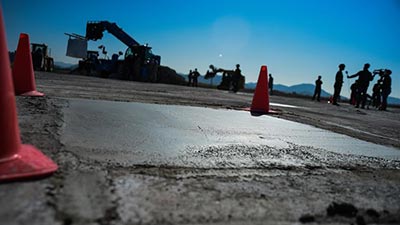How Hot Weather Affects Curing
By default, curing is the actions and conditions which maintain an adequate level of moisture content and temperature in concrete at its early stages. If performed properly, the end result is concrete that develops properties the specific design mix used was intended to achieve. Curing begins quickly after placement and finishing ends so the concrete can develop its desired durability and strength.
Why Is Hydration Necessary For Hot Weather Concrete?
Sufficient moisture levels are crucial for hydration, a reaction between the cementitious materials. Because hot weather frequently impedes proper hydration, understanding how temperature affects the curing process is important.
The rate of hydration generally increases as the temperature increases, ergo increasing the rate of strength development. Yet, to avoid thermal cracking, it’s strongly recommended to maintain a consistent temperature throughout the concrete surface during the curing process.
Without a proper reaction, a quality concrete product rarely results.
Hot Weather Considerations For Concrete
Predictable Strength Gain
When cured in a dry environment, concrete can lose up to 50 percent of its potential strength versus concrete cured in a moist environment. And while high temperature conditions may result in a higher initial strength, the strength is frequently lost over time. Cold weather placement causes slower strength gains which delays form removal and further construction.
Improved Durability
When concrete can cure under suitable conditions, the surface hardness improves along with its ability to withstand surface abrasion and wear. Appropriate curing also allowing the concrete to further develop water tightness which has a direct impact on an increased durability and functional lifespan.
Better Appearance & Serviceability
Any concrete slab allowed to dry out too early has a soft surface and is unable to withstand abrasion and wear. Crazing, dusting, and scaling reduces with adequate curing.
How Do I Cure Concrete In High Temperatures?
Above all, make sure the surface can retain moisture until the final finishing.
What Are Moisture Retaining Materials?
Liquid Membrane-Forming Curing Compounds
It’s essential any of these compounds used comply with ASTM C 309. Apply the compound to the surface one hour after finishing — don’t apply to a still bleeding surface or one with a visible water sheen.
A white pigmented compound provides better reflectivity and ability to inspect the coverage. While a single coat is generally adequate, applying a second coat at right angles to the initial coat allows for even coverage. If the final layer is to be ceramic or vinyl tile, it’s necessary to apply a non-reactive liquid compound. This greatly reduces the risk of a reaction between the compound and adhesive or paint used for the tiles. Another option is to use a compound that can be brushed or washed off the surface.
For floors, protect the concrete surface from other work with scuff-proof paper after applying the curing compound.
Plastic Sheets
Any plastic sheeting used should:
- Be clear, pigmented, or reflective/white;
- Meet ASTM C 171 guidelines;
- Be at least four mils thick; and
- Reinforced with glass fibers.
It’s recommended to use dark-colored sheeting when the ambient temperature falls to 60 degrees Fahrenheit or lower. Conversely, reflective sheeting is recommended for ambient temperatures surpassing 85 degrees Fahrenheit.
Lay the plastic in direct contact with the surface as quickly as possible, but without damage to the surface. Overlap the sheet edges, connect with waterproof tape, and weight down to stop the wind and other sources of air flow from lifting the sheeting. Because it’s possible for wrinkles in the plastic to leave dark streaks from touching the concrete, avoid using this material for surfaces where the final appearance is crucial.
Waterproof Paper
This material is commonly used in the same manner as plastic sheets but without the risk of damaging the surface. Waterproof paper generally has two layers of craft paper cemented together, strengthened with fiber. It should always meet ASTM C 171 guidelines.
What To Use For Hot Weather Moisture Retention
Curing Blankets
These blankets frequently include burlap and/or cotton mats and rugs laid over the surface then dampened with a sprinkler system or soaker hose. Similar to plastic sheeting, the edges of curing blankets should be overlapped, and outermost edges weighted down to prevent lifting by air flow. It’s crucial to keep the blankets damp to prevent the material from absorbing bleed water from the concrete itself.
Dampened Straw, Sand, Sawdust, Or Earth
If using straw, it should be at least six inches in depth and covered with a tarp after sprinkling with water. Moist sand, sawdust, and earth are commonly used in curing flatwork, such as flooring. The materials shouldn’t contain organic or iron-staining pollutants.
Sprinkler System
Using a timed sprinkler system is ideal when the air temperature is well above the freezing point. It ensures the surface is soaked and doesn’t cycle through wet and dried out.
Water Ponding
An outstanding curing method, remember the temperature of the ponded water shouldn’t be more than 20 degrees Fahrenheit cooler than the concrete itself. Make sure the dike around the pond is secured to prevent water leaks.


